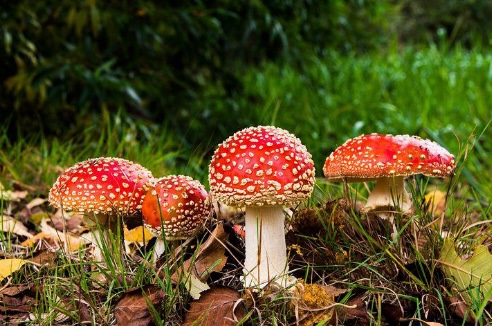One of the most common mushroom species on the Earth is Amanita muscaria, also known as fly agaric. It is difficult to overlook because of its distinctive red and white appearance. But this mushroom is more complex than it first appears.
In a way unmatched by any other psychoactive chemical on Earth, fly agaric is profoundly and bizarrely psychedelic. Some claim that early customs involving this fungus gave rise to the mythology of Santa Claus and his flying reindeer.
Table of Contents
What is an Amanita Muscaria mushroom?
Around the world, softwoods are home to the fungus Amanita muscaria, also known as the Fly Agaric. Although this mushroom is considered a psychedelic, it isn’t truly one, at least not in the traditional sense. But unlike any other psychedelic on the planet, users report alterations in sensory perception. This mushroom produces hallucinations that are best described as lucid; as a result, everything looks distorted, and it is challenging to determine the actual sizes of the self and outside objects. A meaningful visionary experience is exceedingly challenging to have. For it to be genuinely hallucinogenic, you must take enormous amounts, but these doses also come with many unpleasant, perhaps harmful, side effects. More of nitrogen than a true psychedelic, this fungus is.
After consumption effects:
A drug that promotes or creates dreamy states of consciousness is known as an oneirogen. After consuming fly agaric, most individuals fall asleep within a few hours. At this point, the genuine effects of this fungus become apparent, and you are plunged into a peculiar dream world. It is hard to explain or adequately describe the dreams this particular fungus produces after they have ended.
We don’t advise anyone to use this mushroom for its psychedelic effects due to its unpredictable nature and the significant danger of adverse effects. The majority of people that consume this mushroom do not do so again. It’s not a particularly enlightening or joyful experience, and it can even be not very comforting.
To encourage more vivid dreams, most persons who use this mushroom “frequently” (that is, more than once) take little dosages or micro doses. It performs admirably for this, probably too admirably. This mushroom produces difficult-to-understand dreams rarely regarded as “visionary” because they are disorganized and erratic.
Risks Associated with Amanita Muscaria

The effects of Amanita muscaria are extremely toxic. This species is classified as toxic in most mushroom identification books.
According to the North American Mycological Association, there hasn’t been a documented fatality from this mushroom in over 100 years. However, some of the chemicals found in mushroom meat are neurotoxic.
Toxic side effects have still been documented, particularly in individuals taking extremely high dosages or those who already have liver or renal illness.
Fly Agaric Has Unpredictable Effects

This mushroom’s effects might vary considerably. One can consume it and have an incredible, illuminating journey; another might have a nightmare experience that sends them to the hospital. It may not be easy to distinguish between what is real and what is a dream when using fly agaric, which is a deliriant.
These chemicals have a high degree of unpredictability. Some people panic and risk serious bodily injury, while others experience euphoria and a sense of oneness with all of existence. Some people will feel quite normal, with only a tiny pang of “weirdness” in their awareness.
Contains Toxic Compounds in Fly Agaric
Ibotenic acid, one of the active components, is a well-known neurotoxin. It also functions as a prodrug for muscimol, the primary hallucinogenic ingredient. Even at low concentrations, muscimol can be harmful. Muscimol’s LD50 in rats is estimated to be 45 mg/kg and in mice to be 20 mg/kg (orally). This exceeds the usual psychoactive dosage by a wide margin.
Fly agaric also contains a compound called muscarine. Fly agaric contains comparatively tiny levels of this chemical, which can be further decreased by heating or boiling the fungus before consumption.
Inocybe erubescens and numerous Clitocybe species are among the hazardous mushroom species that contain large amounts of muscarine (C. dealbata and C. ribulose).
Finally, it is known that fly agarics bioaccumulate vanadium from the soil in the form of the molecule amavadin. A complex, rare-earth metal called vanadium can be found in minuscule levels in the soil. Vanadium levels in some fly agaric samples have been 400 times higher than those typically seen in plants and fungi. The effects of high quantities of organic vanadium on health are unknown. Vanadium in synthetically enriched forms is very hazardous.
Other Amanita Family Members Are Deadly Poisons

Even though this mushroom is easily distinguished, there have been instances where individuals have mistakenly identified it in the wild, sometimes with fatal results.
The death cap, destroying angel, or fools’ mushroom are a few species of this family of mushrooms that resemble the fly agaric at different stages of maturity. You can also buy dried magic mushrooms in Canada.
This mushroom should only be picked wild if you are confident of the species you are picking.
What does it Feels Like after eating Amanita Muscaria?
The fly agaric fungus differs from other psychedelics in its hallucinogenic properties. It is regarded as an oneirogen psychedelic, while one could also make the case that it is a deliriant. This fungus produces states of awareness similar to dreams. Whether you are physically sleeping or not, this impact still occurs.
The fungus doesn’t cause powerful hallucinations when you’re awake, but it can change how you perceive time and make things seem bigger or smaller than they are.
The effects (often) begin to feel energizing. Ibotenic acid, which hasn’t been changed into the more hallucinogenic and sedative metabolite muscimol, is responsible for this effect.
Users begin to experience weird feelings as the effects set in. It produces a high that is unique among all psychedelics. Users do not feel that they are “tripping” but that everything is becoming strangely “odd.” Most say they first feel upbeat and invigorated, but after about four hours, the effects become profoundly sleepy as more and more ibotenic acid is transformed into muscimol.
The journey then proceeds on a much clearer path. Users frequently drift in and out of sleep, each time having stranger and more vivid nightmares. Dreams are almost hard to explain or make sense of since they are so weird and fuzzy.
Typical reactions to this mushroom include:
- the experience of flight
- expanded awareness of the senses
- Euphoria
- Dreamlike haziness and lucidity
- the sensation of being extremely light or heavy
What Is Amanita Muscaria Side Effects?

The negative consequences of using this fungus are just as unexpected as their beneficial benefits of the magic mushrooms dispensary.
The most frequent negative effects include sleepiness, nausea, and vomiting; however, users have also mentioned several additional possible side effects, including:
- sickness and vomiting
- Sweating \salivation
- reduced blood pressure
- faulty motor coordination (ataxia)
- Changes in mood and irritation
- Delirium
- more frequent urination
- Seizures
The actions of this mushroom are categorized as cholinergic, which means they promo acetylcholine release or activity. The parasympathetic nerve system, which regulates our “relax and digest” reaction and functions in opposition to the sympathetic nervous system, is primarily regulated by this neurotransmitter (fight or flight).
In essence, cholinergic substances promote parasympathetic activity and inhibit sympathetic activity. Excessive salivation, a slowed heartbeat, low blood pressure, sweating, increased urine, and vomiting is some of the adverse side effects.
Conclusion
Amanita muscaria has relatively gradual effects. Up to three hours may pass before any effects are felt. After initially swallowing the mushrooms, the effects typically peak around the 5-hour mark and can last up to 12 hours. After consuming the mushroom, some users report having odd nightmares for up to a week.
